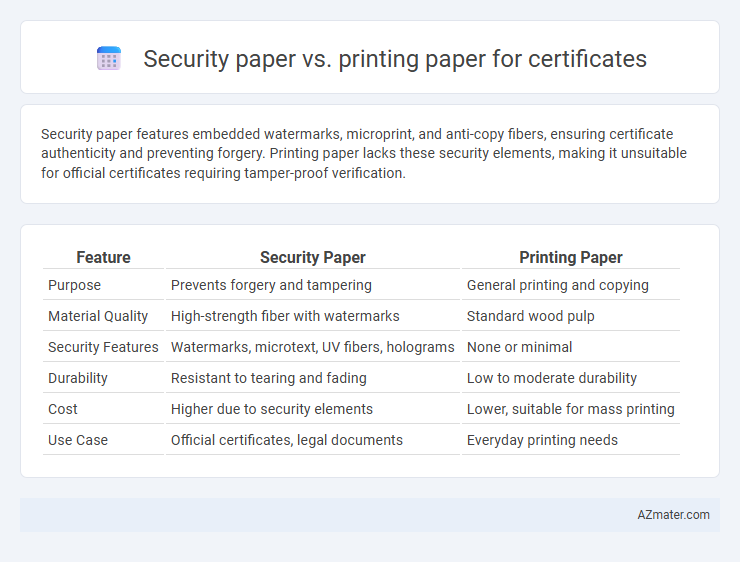Security paper features embedded watermarks, microprint, and anti-copy fibers, ensuring certificate authenticity and preventing forgery. Printing paper lacks these security elements, making it unsuitable for official certificates requiring tamper-proof verification.
Table of Comparison
| Feature | Security Paper | Printing Paper |
|---|---|---|
| Purpose | Prevents forgery and tampering | General printing and copying |
| Material Quality | High-strength fiber with watermarks | Standard wood pulp |
| Security Features | Watermarks, microtext, UV fibers, holograms | None or minimal |
| Durability | Resistant to tearing and fading | Low to moderate durability |
| Cost | Higher due to security elements | Lower, suitable for mass printing |
| Use Case | Official certificates, legal documents | Everyday printing needs |
Introduction to Security Paper and Printing Paper
Security paper incorporates embedded security features such as watermarks, security threads, and microprinting to prevent counterfeiting and ensure document authenticity, making it ideal for certificates and official documents. Printing paper, designed primarily for high-quality image and text reproduction, offers smoothness and brightness but lacks tamper-evident elements critical for secure certification. Selecting security paper enhances document integrity by combining durability with anti-fraud technologies unavailable in standard printing paper.
Key Differences Between Security Paper and Printing Paper
Security paper incorporates specialized features such as watermarks, embedded fibers, and anti-counterfeiting elements that protect certificates from forgery and tampering. Printing paper used for certificates lacks these security attributes and is designed primarily for high-quality printing and durability but offers minimal protection against fraud. The key difference lies in security paper's ability to authenticate documents and prevent duplication, making it essential for official certificates compared to standard printing paper.
Importance of Security Features in Certificates
Security paper incorporates specialized features such as watermarks, microprinting, and holograms that prevent counterfeiting and unauthorized duplication, making it essential for certificates requiring authenticity verification. Printing paper lacks these advanced security elements, increasing the risk of forgery and undermining the certificate's credibility. Employing security paper ensures the integrity and trustworthiness of certificates by safeguarding against tampering and fraudulent reproduction.
Types of Security Paper Used for Certificates
Security paper for certificates includes watermarked paper, which incorporates embedded patterns visible when held against light, and microprinted paper featuring tiny printed text that deters forgery. Threaded security paper contains metallic or colored threads woven into the fibers, enhancing tamper resistance. Chemical reactive paper changes color upon exposure to solvents, preventing unauthorized alteration, whereas standard printing paper lacks these anti-counterfeiting measures and is more susceptible to duplication.
Common Printing Paper Options for Certificates
Common printing paper options for certificates include security paper and standard printing paper, each offering distinct features suited to different needs. Security paper incorporates built-in anti-counterfeiting measures such as watermarks, microprinting, and chemical sensitivity to prevent forgery and tampering, making it ideal for official documents and diplomas. In contrast, regular printing paper, typically composed of standard wood pulp, provides a smooth surface and affordability but lacks the protective elements needed for high-security certifications.
Advantages of Security Paper for Certification
Security paper for certificates offers advanced protection against counterfeiting and tampering due to embedded features such as watermarks, microtext, and UV-reactive fibers. These security elements enhance authenticity verification, ensuring the certificate's credibility and reducing fraud risk. Compared to regular printing paper, security paper maintains durability and professional appearance while providing a reliable safeguard for official documents.
Risks of Using Regular Printing Paper for Certificates
Using regular printing paper for certificates increases risks such as easy forgery, damage, and lack of durability. Security paper incorporates watermarks, holograms, and special fibers that enhance authenticity and prevent counterfeiting. Certificates printed on standard paper are more susceptible to tampering, fading, and deterioration over time, compromising their credibility.
Cost Considerations: Security Paper vs Printing Paper
Security paper typically incurs higher costs than standard printing paper due to embedded features like watermarks, holograms, and anti-copy patterns that deter forgery and enhance certificate authenticity. Printing paper offers a more budget-friendly option but lacks these tamper-resistant attributes, increasing the risk of counterfeit certificates. Organizations must balance upfront expenses with long-term savings by choosing security paper to minimize fraud-related losses and protect brand integrity.
Applications and Best Practices for Certificate Printing
Security paper offers tamper-resistant features such as watermarks, microprinting, and embedded security fibers, making it ideal for certificates requiring high authenticity and fraud prevention. Printing paper for certificates is suitable for standard applications where cost-effectiveness and smooth ink absorption are prioritized, often used for internal or low-risk documents. Best practices for certificate printing involve selecting appropriate paper weight and finish while ensuring the printing method complements security features for durability and professional appearance.
Conclusion: Choosing the Right Paper for Secure Certificates
Security paper integrates advanced features such as watermarks, microtext, and UV-reactive fibers that significantly reduce the risk of forgery, making it the preferred choice for certificates requiring high levels of authenticity. Printing paper, while cost-effective and suitable for standard document production, lacks these anti-counterfeiting measures and is vulnerable to duplication and tampering. Opting for security paper ensures enhanced protection and trustworthiness for official certificates where verification and legitimacy are paramount.

Infographic: Security paper vs Printing paper for Certificate
 azmater.com
azmater.com